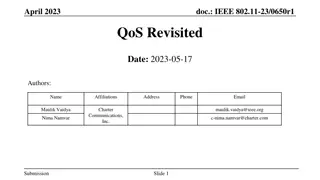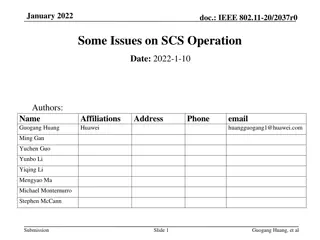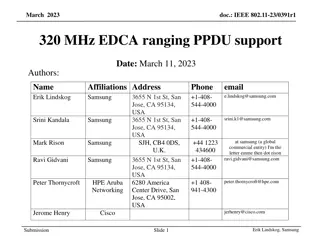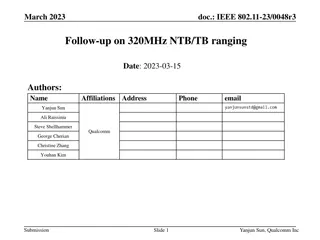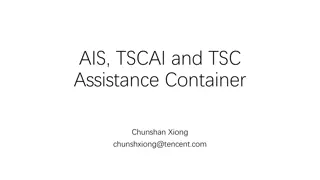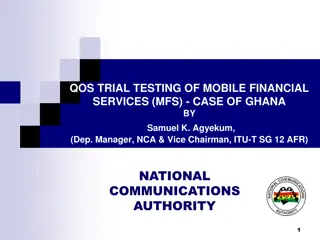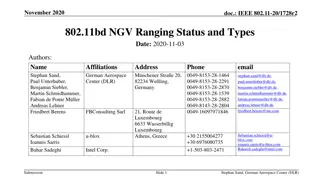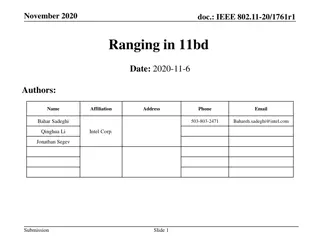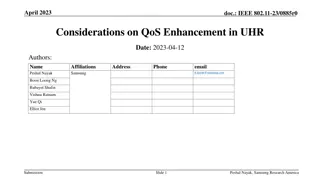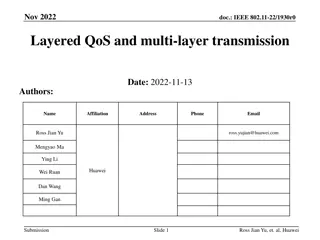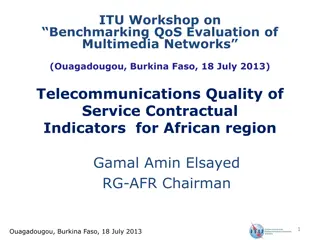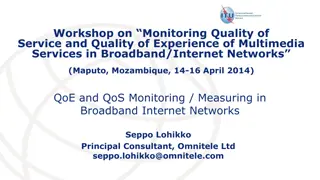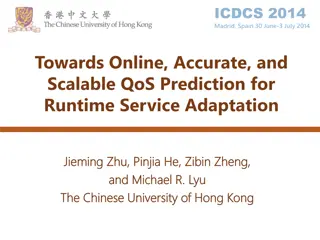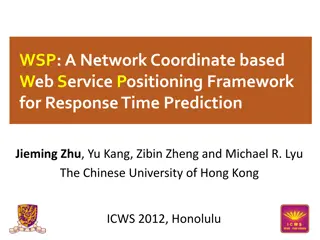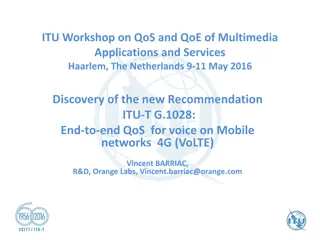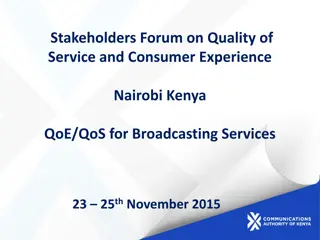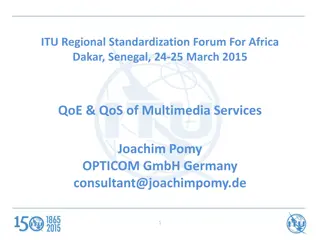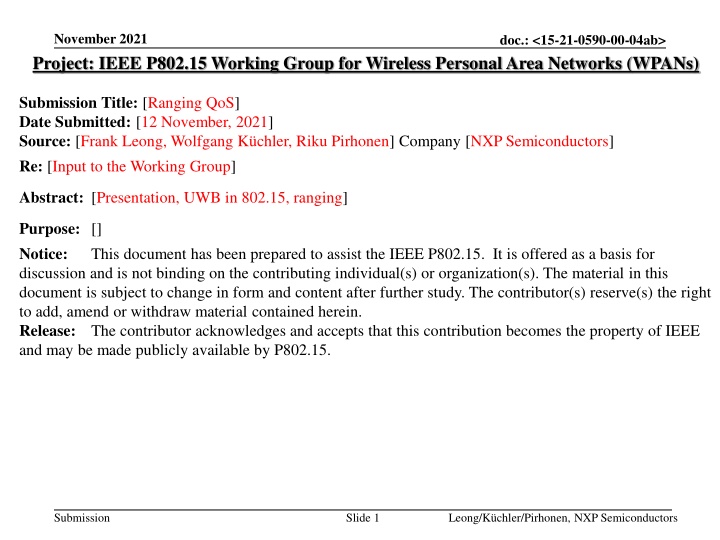
Enhancing Wireless Personal Area Networks (WPANs) with Ranging Quality of Service
Explore the latest contributions and proposals from NXP Semiconductors to the IEEE P802.15 Working Group for Wireless Personal Area Networks (WPANs). The submission focuses on improving ranging quality of service (QoS) through advancements in UWB technology and interference mitigation techniques. Key aspects include high data rates, modulation structure enhancements, expanded operating frequencies, and support for various communication protocols. The document outlines a comprehensive approach to address the challenges of high-throughput data use cases without disrupting low-duty-cycle ranging scenarios.
Download Presentation

Please find below an Image/Link to download the presentation.
The content on the website is provided AS IS for your information and personal use only. It may not be sold, licensed, or shared on other websites without obtaining consent from the author. If you encounter any issues during the download, it is possible that the publisher has removed the file from their server.
You are allowed to download the files provided on this website for personal or commercial use, subject to the condition that they are used lawfully. All files are the property of their respective owners.
The content on the website is provided AS IS for your information and personal use only. It may not be sold, licensed, or shared on other websites without obtaining consent from the author.
E N D
Presentation Transcript
November 2021 Project: IEEE P802.15 Working Group for Wireless Personal Area Networks (WPANs) doc.: <15-21-0590-00-04ab> Submission Title: [Ranging QoS] Date Submitted: [12 November, 2021] Source: [Frank Leong, Wolfgang K chler, Riku Pirhonen] Company [NXP Semiconductors] Re: [Input to the Working Group] Abstract: [Presentation, UWB in 802.15, ranging] Purpose: [] Notice: discussion and is not binding on the contributing individual(s) or organization(s). The material in this document is subject to change in form and content after further study. The contributor(s) reserve(s) the right to add, amend or withdraw material contained herein. Release: The contributor acknowledges and accepts that this contribution becomes the property of IEEE and may be made publicly available by P802.15. This document has been prepared to assist the IEEE P802.15. It is offered as a basis for Submission Slide 1 Leong/K chler/Pirhonen, NXP Semiconductors
November 2021 doc.: <15-21-0590-00-04ab> PAR Objective Safeguards so that the high throughput data use cases will not cause significant disruption to low duty-cycle ranging use cases Interference mitigation techniques to support higher density and higher traffic use cases Other coexistence improvement Backward compatibility with enhanced ranging capable devices (ERDEVs) Improved link budget and/or reduced air-time Proposed Solution (how addressed) High data rates, preamble modification High data rates, preamble modification Lower data rates for control and report messages Highly similar modulation structure Lower data rates for control and report messages, higher data rates for reduced air-time Additional channels and operating frequencies Improvements to accuracy / precision / reliability and interoperability for high-integrity ranging Reduced complexity and power consumption Hybrid operation with narrowband signaling to assist UWB Enhanced native discovery and connection setup mechanisms Sensing capabilities to support presence detection and environment mapping Low-power low-latency streaming Higher data-rate streaming allowing at least 50 Mbit/s of throughput Support for peer-to-peer, peer-to-multi-peer, and station-to- infrastructure protocols Infrastructure synchronization mechanisms Outlining key aspects of PHY assisting UWB Outlining key aspects of PHY assisting UWB Outlining key aspects of PHY assisting UWB High data rates High data rates Submission Slide 2 Leong/K chler/Pirhonen, NXP Semiconductors
November 2021 doc.: <15-21-0590-00-04ab> Ranging QoS Submission Slide 3 Leong/K chler/Pirhonen, NXP Semiconductors
November 2021 doc.: <15-21-0590-00-04ab> 802.15.4ab Context Recap Focus on key functionalities to be provided by UWB: 1.Ranging with high integrity (handsfree access use cases) 2.Localization (indoor navigation use cases) 3.Sensing (presence detection use cases) 4.Coordination & scheduling to support the above Provide accurate ranging via a low-cost, mass-market solution a. Low energy-per-ranging b. Low channel-occupancy-per-ranging a.k.a. spectral efficiency (many devices operating at the same time & place) c. Re-use of hardware between use cases Submission Slide 4 Leong/K chler/Pirhonen, NXP Semiconductors
November 2021 doc.: <15-21-0590-00-04ab> UWB Ranging Improving QoS (802.15.4z HRP UWB as Baseline) Lower data rate option for link budget benefit Improves resilience to dispersion/fading, interference Higher data rate option for reduced airtime Preamble options for enhanced channel capacity Wake-up (WUP) PHY Reduced system cost (RF components, energy consumption) Low latency QoS improvements on Ranging will typically also (partially) carry over to Localization and Sensing Submission Slide 5 Leong/K chler/Pirhonen, NXP Semiconductors
November 2021 doc.: <15-21-0590-00-04ab> Balancing Preamble and Data Refer to 1.7 Mbit/s proposal from TG4z, see: https://mentor.ieee.org/802.15/dcn/20/15-20-0037-00-004z-hrp-lower-rate-data-format.pptx Balance between preamble and data improves resilience to fading, and also to interference Benefit to protocols in which UWB is used for status and timestamp signaling (e.g., Gen1 Digital Key protocols) Recommendation: PHR rate scaling as in 802.15.4z HPRF (linked to FEC) Mitigation of long scrambler run-in sequences could be useful (lowering Peak EIRP), if a low-complexity method can be devised Submission Slide 6 Leong/K chler/Pirhonen, NXP Semiconductors
November 2021 doc.: <15-21-0590-00-04ab> Reducing Air-Time (I) Higher data rates provide a means to reduce air-time Beneficial in short-range scenarios (e.g., contactless payment at a terminal) Performance related to properties of the wireless channel (RMS delay spread) Find a balance between data transfer capability and implementation complexity Propose Burst-Level QPSK (BQPSK*) Consider channel estimation, equalization, FEC choice *: BQPSK is essentially a form of QPSK; for relative comparison to other common schemes, see: https://www.gaussianwaves.com/2010/04/performance-comparison-of-digital-modulation-techniques-2/ Submission Slide 7 Leong/K chler/Pirhonen, NXP Semiconductors
November 2021 doc.: <15-21-0590-00-04ab> Reducing Air-Time (II) BPSK Acc. HPRF 1 symbol (64 chips) 8 pulses spread 2x, BPSK scrambled, burst BPSK modulated 8 pulses spread 2x, BPSK scrambled, burst BPSK modulated guard interval (16 chips) guard interval (16 chips) Burst-Level QPSK (BQPSK) Equivalent 1 symbol (64 chips) 16 pulses spread 2x, BPSK scrambled, burst QPSK modulated guard interval (32 chips) Same data rate, but 2x longer guard interval 1 symbol (32 chips) 8 pulses spread 2x, BPSK scrambled, burst QPSK modulated 2x higher data rate, but same guard interval guard interval (16 chips) Higher Rate BQPSK Submission Slide 8 Leong/K chler/Pirhonen, NXP Semiconductors
November 2021 doc.: <15-21-0590-00-04ab> Reducing Air-Time (III) BQPSK has 2x longer guard interval vs. BPSK for same data rate Better performance in dense multipath environments Strong benefit for low-complexity EQ schemes BQPSK is scalable; feasibility of a specific data rate depends on UWB wireless channel properties (RMS delay spread) Channel sounding typically results in a delay distribution as pictured (example for LOS @ 2 m spacing in a clutter-rich indoor environment) RMS delay spread scales w/ distance: e.g., ~18 ns for 2 m, ~4 ns for 0.1 m (TYP across various locations in clutter-rich indoor environment) Submission Slide 9 Leong/K chler/Pirhonen, NXP Semiconductors
November 2021 doc.: <15-21-0590-00-04ab> Reducing Air-Time (IV) RMS delay spread of ~10 ns expected in short-range scenarios (both LOS and NLOS, both CH5 and CH9) Correspondingly, BQPSK up to ~50 Mbit/s would be feasible 54.4 Mbit/s with CCK=3+RS rate 1/2 FEC 62.4 Mbit/s with CCK=7 rate 1/2 FEC (higher w/ puncturing*) Delay spread in the UWB wireless channel will limit the applicability of higher BQPSK data rates *: See: D. Haccoun and G. Begin, High-rate punctured convolutional codes for Viterbi and sequential decoding, IEEE Transactions on Communications, vol. 37, no. 11, pp. 1113-1125, Nov. 1989. Note that memory M in this paper is defined such that M=6 translates to K=7. Submission Slide 10 Leong/K chler/Pirhonen, NXP Semiconductors
November 2021 doc.: <15-21-0590-00-04ab> Preamble Options (I) Proposing PRFDMA (Pulse Repetition Frequency Domain Multiple Access) as means to balance UWB multi-user performance vs. hardware cost Beneficial in dense multi-user scenarios, for example: Indoor Navigation (e.g., shopping mall) with a peak density of ~5 persons/m2 within a ~100 m radius Digital Key in a parking lot after large event, >10k parking spots within a radius of ~1 km at a peak density of ~0.1 vehicles/m2 Submission Slide 11 Leong/K chler/Pirhonen, NXP Semiconductors
November 2021 doc.: <15-21-0590-00-04ab> Preamble Options (II) Subnet separation via preambles is desirable Mitigates receiver blind time when acquiring undesired signal Already part of HRP UWB (both BPRF and HPRF) Further enhancements proposed, see: https://mentor.ieee.org/802.15/dcn/21/15-21-0377-02-04ab-preamble-codes-for-data-communications.pptx PRFDMA provides cross-correlation performance within ~1dB of proposed length-2047 m-sequences PRFDMA does not require major modem modifications, no increase in hardware complexity/cost Depending on parameter choice, PRFDMA provides ~50 subnets Probably makes most sense as an HPRF enhancement Several specific code-to-PRF assignment designs possible, either based on length-91 Ipatov sequences or length-127 m-sequences Submission Slide 12 Leong/K chler/Pirhonen, NXP Semiconductors
November 2021 doc.: <15-21-0590-00-04ab> Preamble Options (III) Proposal: Specify chip rate clock tuning range of 2% in 800 ppm steps This combination of range and step size provides 51 subnets Carrier frequency remains untouched Both chip rate and carrier clocks derived from same reference (i.e., no change compared to 15.4z) Transmit the entire packet with the specified chip rate clock Avoid variable chip rate clock frequency within the packet Support pulse shaping with a multiple of the chip rate clock (avoid re-shaping for each chip rate clock frequency) Accommodate the full chip rate clock frequency range in transmit masks (both time and frequency domain) Submission Slide 13 Leong/K chler/Pirhonen, NXP Semiconductors
November 2021 doc.: <15-21-0590-00-04ab> WUP PHY Additional PHY to serve as Wake-Up (WUP) Low energy consumption, both in Scanning and Advertising mode Sufficient link budget not bottlenecking overall UWB application Tightly coupled to UWB (timing and channel properties) Consider interference scenarios & coexistence features Focus on low cost Antenna & filter sharing Avoid high complexity Submission Slide 14 Leong/K chler/Pirhonen, NXP Semiconductors


